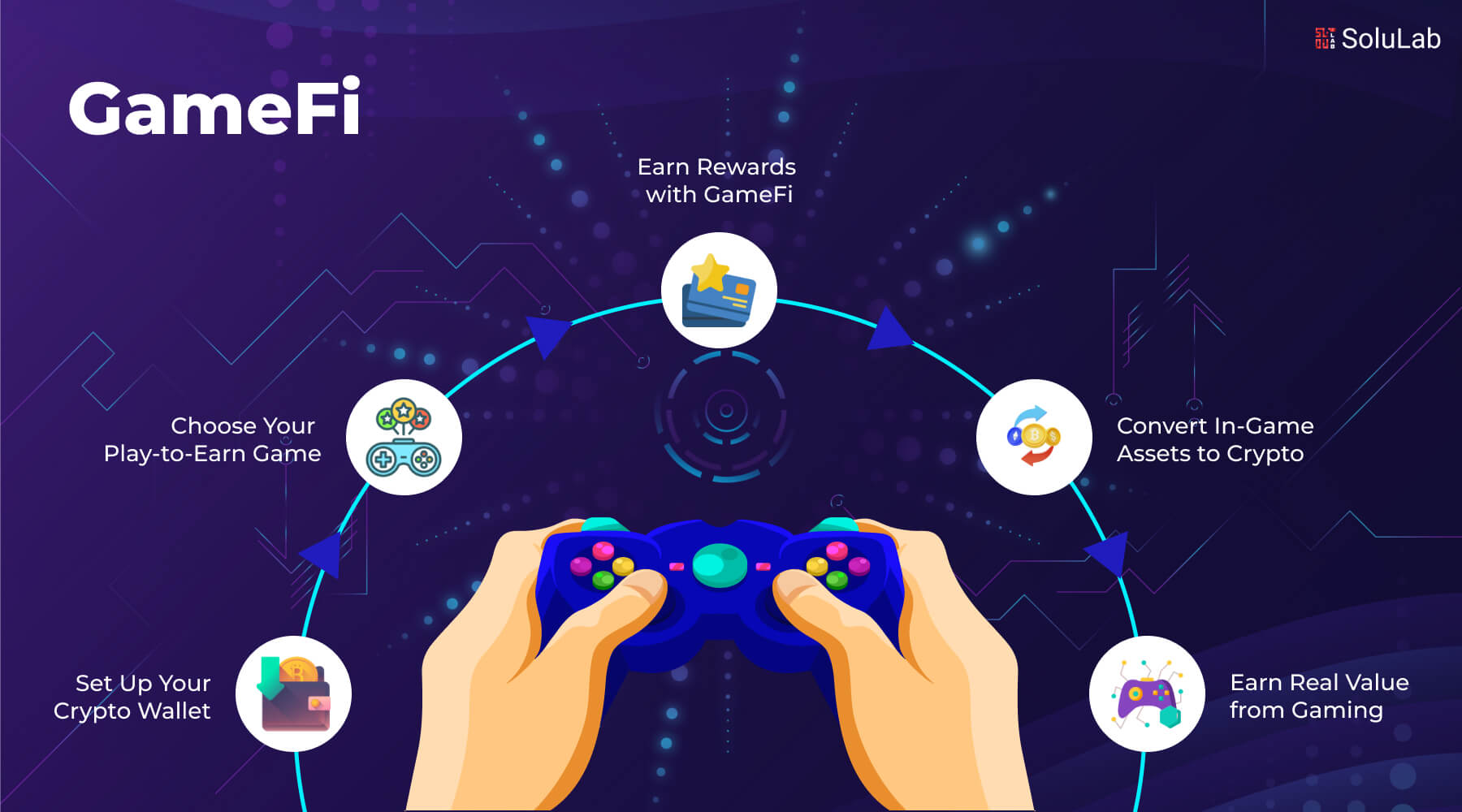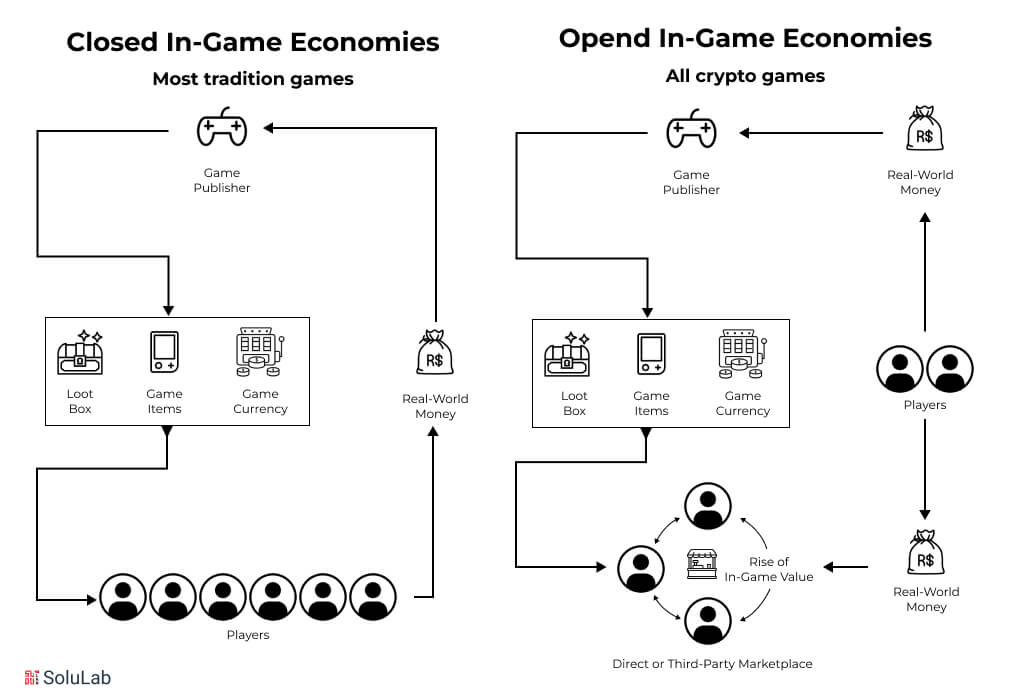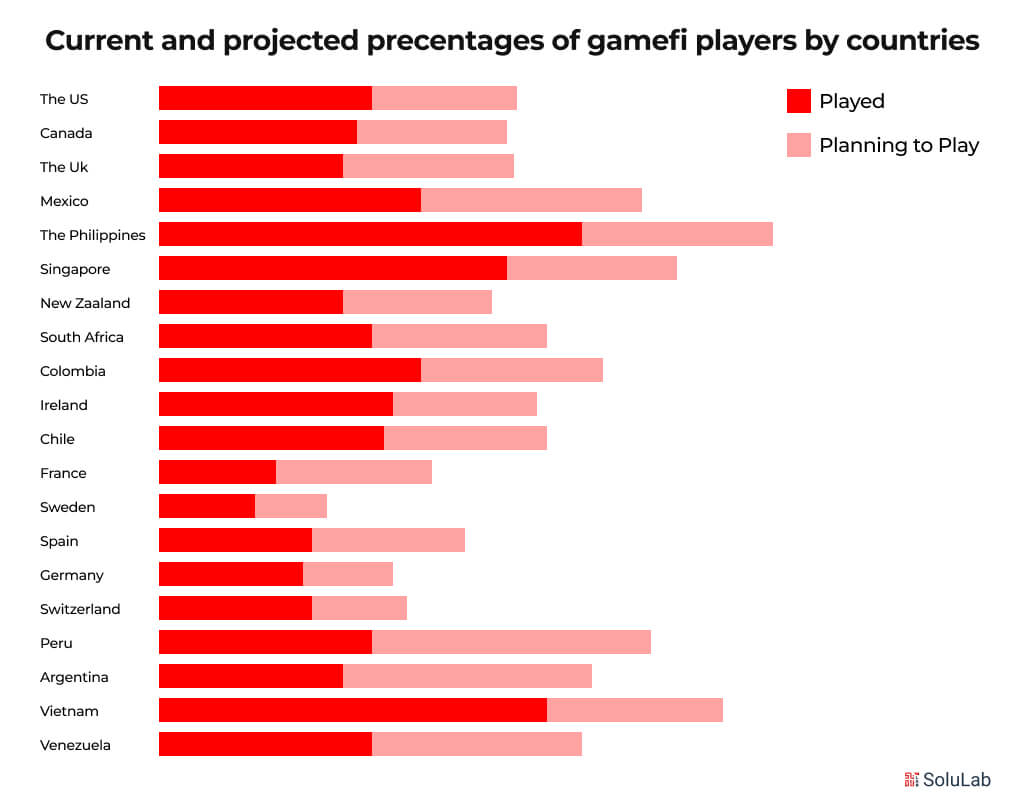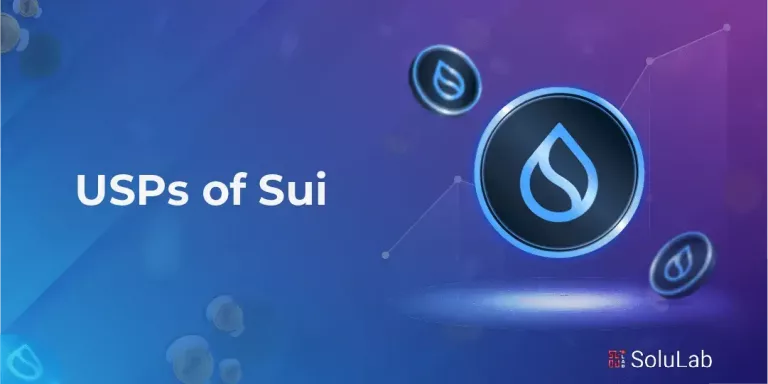
In a global survey, a substantial 75% of respondents confessed that their initial foray into cryptocurrency was solely motivated by GameFi. This remarkable figure indicates that three out of every four cryptocurrency investors worldwide commence their crypto journey driven by the allure of GameFi.
Regarding GameFi’s success, numerical facts hold more weight than mere words. In 2021, the global play-to-earn (P2E) market was estimated to be valued at approximately USD 777 million. This figure is projected to witness an exponential surge over the next decade. With millions of individuals actively participating in P2E games on a regular basis, this industry presents an attractive business opportunity. Some of the most renowned GameFi projects, like Axie Infinity, boast an impressive 2.7 million active monthly users, showcasing the enormous potential of this market.
How Does GameFi Work?
GameFi, a fusion of “gaming” and “finance,” changing how people play and earn simultaneously. It allows players to engage in games and accrue cryptocurrency rewards, blurring the line between entertainment and financial gain.
1. The Gaming Element
Begin your gaming journey by selecting a game that aligns with your interests, be it a mystical fantasy adventure or a peaceful farming simulation. As you play, engage in missions or challenges to progress through the game.
2. Earning Through Play
During gameplay, you have the opportunity to acquire in-game items such as swords, skins, or even virtual land. These items are frequently represented as NFTs, which are distinctive digital tokens. Remarkably, you have the ability to sell these items on various marketplaces for actual currency.
3. The Role of Cryptocurrency
Many GameFi platforms incorporate their own distinctive virtual currency. Engaging in the game allows players to acquire this currency, which can subsequently be utilized within the game itself or traded for alternative cryptocurrencies or even conventional currencies like fiat money.
4. Investing to Earn More
In some games, you can enhance your gaming experience by purchasing unique items or engaging in cryptocurrency “staking.” This investment strategy can yield increased rewards as you progress through the game.
5. Community and Governance
In numerous GameFi games, players have the ability to influence the direction of the game’s development. Through the use of earned tokens, players can participate in voting processes to express their opinions on proposed new features or modifications within the game.

How are GameFi Platforms Different from Regular Video Games?
In the gaming world, players can engage in GameFi games, which feature distinct mechanics and prerequisites. To participate, players must possess crypto wallets for token storage. Additionally, these wallets must be funded with cryptocurrency before commencing gameplay. Some games may also require the purchase of starter characters to initiate the gaming journey. Traditional games also provide digital currency and assets that players can utilize to enhance their characters and augment their gaming experience. However, these assets are restricted to the game’s ecosystem and lack external value beyond the gaming platform. As a result, players cannot engage in trading or monetizing these assets, rendering them economically disadvantageous. In contrast, GameFi platforms offer players tokens and assets, often in the form of NFTs or cryptocurrencies. Even if certain blockchain games employ virtual tokens, players have the ability to exchange their in-game assets for NFTs when necessary. Furthermore, players can seamlessly transfer their earnings to their crypto wallets or NFT marketplaces, converting them into traditional money, making the concept of GameFi play-to earn a significant aspect of modern gaming.
1. Earning Real Value
In traditional video games, players typically engage with in-game currencies and items that have no monetary value.
In contrast, GameFi platforms offer players the opportunity to earn cryptocurrency and non-fungible tokens (NFTs) while playing. These digital assets can be traded on marketplaces for money, allowing players to monetize their gaming experience.
2. Ownership of Assets
In conventional video games, items and characters obtained through gameplay are confined within the game’s virtual. However, GameFi, empowered by blockchain technology, changing this concept by granting players genuine ownership of their acquired assets. Unlike traditional games, GameFi allows players to freely trade or sell these assets, empowering them with unprecedented control and flexibility. This model is often referred to as Play-to-Earn (P2E), highlighting the financial opportunities available to players..
DO YOU KNOW? 34% of respondents from India indicated that they actively engage in play-to-earn (P2E) games, solidifying India’s position as the country with the most significant GameFi fan base.
3. Play-to-Earn Model
In video games, the traditional pay-to-play and free-to-play models have long dominated the industry. However, GameFi changing this domain by presenting a novel play-to-earn model. This concept allows players to be compensated for their gaming efforts with digital assets that possess monetary value.
4. Decentralization
GameFi platforms often function on decentralized networks, unlike regular games controlled and managed by specific companies. This decentralized structure ensures that GameFi platforms are not subject to the control of a single entity.
5. Investment Opportunities
GameFi offers a unique investment opportunity that transcends the traditional spending model of regular games. Here, players have the ability to inject capital into in-game assets or cryptocurrencies, transforming their gaming experience into a potential source of financial return.
6. Community Governance
In traditional video games, the game studio makes all the decisions regarding development and updates. In contrast, GameFi crypto often incorporates token-based voting systems, enabling players to actively participate in changing the game’s future through their votes. This approach gives players a voice in the decision-making process, fostering a sense of ownership and community engagement within the gaming ecosystem.
GameFi Use cases
In P2E gaming, popular online and metaverse app activities include:
- Creating and Selling Virtual Assets: Players can design and sell unique in-game items, such as digital pets or virtual real estate, to other players in exchange for digital assets. This endeavor can be especially profitable for skilled developers capable of creating highly sought-after items.
- Trading: Gamers can engage in trading in-game virtual assets with other players. This activity can be particularly appealing to those interested in collecting rare or exclusive virtual items.
- Staking: Some GameFi platforms offer staking options, allowing players to stake their digital assets in exchange for participating in game governance or specific in-game activities. What is GameFi? Staking provides players with a means to generate passive income while contributing to the development and growth of the game or metaverse.
Benefits of GameFi

The benefits of GameFi platforms are numerous and varied. Here are some of the key advantages:
- Play-to-earn model: GameFi platforms offer a unique play-to-earn model that allows players to earn valuable cryptocurrency tokens or NFTs by playing games. This can provide a fun and engaging way to earn money, and it can also help to offset the costs of gaming.
- Ownership of in-game assets: GameFi platforms often allow players to own their in-game assets, such as characters, items, and land. This can give players a sense of ownership and control over their gaming experience, and it can also make it possible for them to trade or sell their assets to other players, driving interest in GameFi Development.
- Transparency and fairness: GameFi platforms are often built on blockchain technology, which provides a high level of transparency and fairness. This can help to ensure that all players are treated equally, and it can also help to prevent cheating and fraud.
- Potential for passive income: Some GameFi platforms offer players the opportunity to earn passive income by staking their tokens or NFTs. This can provide a way to generate income even when you’re not actively playing the game, showcasing Examples of GameFi Platforms that maximize user engagement and rewards.
- Innovation and creativity: GameFi platforms are constantly innovating and creating new ways to engage and reward players. This can help to keep gaming fresh and exciting, and it can also lead to the development of new and gaming experiences involving GameFi Activities.
- Community-driven development: GameFi platforms are often driven by their communities, which helps to ensure that the games are developed in a way that meets the needs and desires of the players. This can help to create games that are more fun, engaging, and rewarding.
DO YOU KNOW? In regions like Hong Kong and the UAE, GameFi has gained considerable popularity, engaging 29% and 27% of gamers, respectively, in this gaming trend
GameFi Risks
GameFi has sparked controversy due to various factors, with one of the primary concerns running around Environmental, Social, and Governance (ESG) risks.
For instance, there is apprehension regarding the environmental impact of GameFi; the energy consumption associated with blockchain networks has raised flags. Despite the controversies, GameFi’s allure continues to resonate with gamers, developers, and investors, fueling its growth in popularity. As the market segment matures, it is anticipated that regulators will address concerns related to the connection between GameFi and gambling. Appropriate safeguards will need to be implemented to ensure the gaming ecosystem adheres to local laws and regulations, highlighting various GameFi use cases.
GameFi Examples
All entities, including items, creatures, cards, and currencies, are tokenized and eligible for trading on marketplaces.
1. Axie Infinity
Axie Infinity, a strategy game featuring unique, axolotl-inspired digital pets known as Axies, offers players an engaging experience. Players can purchase Axies from other players on the open market, forming teams of three and engaging in battles through various game modes. Victories in battles and successful mission completions reward players with the game’s native currency, SLP. This currency has multiple in-game applications, including crafting runes and charms and breeding new Axies, adding depth and strategy to the gameplay. Additionally, the integration of decentralized finance (DeFi) elements enhances the overall player experience by providing new ways to earn and trade assets.
2. Gods Unchained
Gods Unchained, a collectible trading card game (TCG), allows players to buy, sell, and trade NFT cards with varying rarities. Each card features unique abilities and statistics, enabling players to create customized decks. Within the game, players can engage in battles against one another using their decks. By winning these battles, players ascend the leaderboards and earn GODS tokens. These tokens can be utilized for purchasing new card packs or staked as part of the game’s governance mechanism.
3. Sorare
Sorare, a fantasy sports game, brings together global enthusiasts who collect NFT player cards. These cards serve as gateways to tournaments mirroring real-life player performances across prominent sports leagues worldwide. Much like traditional fantasy sports leagues, Sorare players immerse themselves in league participation, curating their line-ups for each game day. Points are awarded based on the combined performance of their line-up and the rarity of each card. As card rarities ascend, so do the point boosts, offering players a better experience. Furthermore, new cards are introduced through exciting auction-style formats, while tournament victories are celebrated with additional card rewards for the winning players. This captivating experience exemplifies the concept of game finance, merging entertainment with financial opportunities in the gaming world.
How To Earn Money by Playing Games Online?
To earn money through GameFi, a combination of skill, strategy, and luck is required. Before joining any platform, it’s crucial to research popular and reputable GameFi platforms and understand their tokenomics (economic models). Crypto experts advise new gamers to start by investing a small amount of time and resources to test the platform’s withdrawal policies and procedures and assess its reliability without risking significant losses. Once a GameFi platform is chosen, players will need to create an account, usually involving providing basic personal information and setting up a wallet address for winnings. The process for cashing out earnings varies from platform to platform. Some have minimum withdrawal limits that must be met, and platforms may charge a withdrawal fee for converting tokens or cryptocurrency into fiat currency or other digital assets, often using a gamefi token for transactions.
How to Get Started with GameFi?
To get started with GameFi, follow these easy steps:
1. Choose a game: There are many different GameFi games to choose from, so take some time to browse and find one that interests you. Consider factors such as the game’s genre, graphics, gameplay, and tokenomics.
2. Create a wallet: You will need a cryptocurrency wallet to store your in-game assets and tokens. There are many different wallets available, so choose one that is reputable and secure.
3. Purchase cryptocurrency: You will need to purchase cryptocurrency to use in GameFi games. The most popular cryptocurrency for GameFi is Ethereum, but there are also many other cryptocurrencies that are supported.
4. Connect your wallet to the game: Once you have purchased cryptocurrency, you will need to connect your wallet to the game. This will allow you to transfer cryptocurrency into the game and start playing.
5. Start playing: Once your wallet is connected, you can start playing the game. Be sure to read the game’s documentation to learn how to play and how to earn rewards.
6. Withdraw your earnings: Once you have earned rewards, you can withdraw them to your wallet. The process for withdrawing rewards will vary depending on the game, allowing you to enjoy the benefits of GameFi.
Here are some additional tips for getting started with GameFi:
- Do your research: Before you invest in any GameFi game, be sure to do your research and make sure that it is a legitimate project. There are many scams in the GameFi space, so it is important to be careful.
- Start small: When you first start playing GameFi, it is a good idea to start small. This will help you to learn the ropes of the game and to avoid losing too much money.
- Have fun: GameFi is a great way to earn rewards while having fun. So be sure to relax and enjoy yourself.
The Growth and Future of GameFi
GameFi platforms took the gaming and blockchain world by storm in 2021 and continue to hold their ground, chaning the gaming industry with their “play-to-earn” model. Today, players have an array of play-to-earn games to choose from across various blockchains like Ethereum, Polygon, Harmony, and Solana, thanks to the widespread acceptance of GameFi. A report by DappRadar reveals the existence of over 1,400 blockchain-centric games, showcasing GameFi’s growing popularity. While GameFi’s roots can be traced back to the early days of cryptocurrency, it has only recently captured the attention of mainstream gamers. A shining example of GameFi’s success is Axie Infinity, which made history in August 2021 by becoming the first blockchain game to register over $1 billion in token sales. According to activeplayers.io, Axie Infinity had an impressive average of 2,670,416 daily players in April 2022, symbolizing GameFi’s escalating global popularity.
The global gaming community is increasingly warming up to GameFi platforms, and experts anticipate that GameFi will carve out a significant share of the $175 billion video games market. As of now, GameFi’s market capitalization stands at approximately US $55.38 billion, according to data from crypto.com. The enticing earning opportunities presented by GameFi platforms have been instrumental in broadening their fanbase. Some industry experts even forecast that gaming will pave the way for blockchain adoption on a larger scale. This sentiment resonates with the broader understanding of crucial blockchain concepts, such as tokenization, NFTs, and in-game currency, among gamers worldwide.

GameFi is undoubtedly at the dawn of a promising future, as evidenced by the success stories of Axie Infinity and other GameFi platforms operating on different blockchain protocols. However, predicting the novel features and technological advancements that will change future GameFi platforms is challenging, given the continuous evolution of blockchain technology. Future blockchain innovations promise to bring smarter solutions, but their impact on GameFi and their potential to enrich and monetize existing experiences remain an exciting mystery. As blockchain technology continues to evolve, GameFi platforms will likely incorporate more sophisticated features and technologies, offering gamers immersive and rewarding experiences. This leads to the question, how does GameFi work in this growing changing world?
Let’s Create Your Next Big Success In Crypto Gaming!
In summary, GameFi is upgrading the gaming industry by combining blockchain technology with gaming to offer players opportunities to earn rewards through play-to-earn models. The rise of crypto games is opening new doors for both gamers and developers, offering a decentralized, player-driven economy. As this space continues to evolve, businesses need to harness its potential to stay competitive.
At SoluLab, we specialize in GameFi and crypto game development, helping businesses create engaging, blockchain-powered gaming experiences. We understand the challenges of developing secure, scalable, and immersive crypto games, and our expert team is equipped to solve these by offering end-to-end solutions, from concept to deployment. Whether you’re looking to build a GameFi platform or integrate play-to-earn features, we are here to ensure your project succeeds by combining deep blockchain expertise with game design. Let SoluLab be your partner in driving the future of gaming forward as a play-to-earn development company.
Schedule a free consultation
FAQs
1. What is GameFi?
GameFi refers to a combination of gaming and decentralized finance (DeFi) that enables players to earn rewards through blockchain-based games. It creates a unique ecosystem where gaming and finance intersect, allowing players to monetize their gaming activities.
2. How does GameFi work?
GameFi operates by utilizing blockchain technology to provide players with ownership of in-game assets. Players earn gamefi tokens through various GameFi activities, including playing games, trading assets, and participating in decentralized finance (DeFi) Platforms. These tokens can then be traded or sold on various platforms.
3. What are some Examples of GameFi Platforms?
Several popular platforms exemplify the GameFi play-to earn model, including Axie Infinity, Decentraland, and Sorare. Each platform offers unique gameplay experiences that allow players to earn cryptocurrency while engaging with the game’s ecosystem.
4. What are the benefits of GameFi?
The benefits of GameFi include genuine ownership of in-game assets, the potential for passive income through staking, and the ability to trade assets freely. Additionally, players can engage in a decentralized economy that enhances their gaming experiences and rewards.
5. What is game finance?
Game finance refers to the financial aspects of gaming, particularly in the context of blockchain technology. It encompasses various economic models, including Play-to-Earn (P2E) structures that allow players to earn money through their gaming activities.
6. How is GameFi related to decentralized finance (DeFi)?
GameFi is closely related to decentralized finance (DeFi) as it utilizes blockchain technology to create a player-driven economy. This integration allows players to earn and trade assets in a decentralized manner, providing them with financial opportunities within the gaming space.
7. What is GameFi Development?
GameFi Development involves creating blockchain-based games that incorporate elements of finance, allowing players to earn rewards through gameplay. This field includes designing engaging game mechanics, ensuring secure transactions, and integrating gamefi tokens for a seamless gaming experience.






